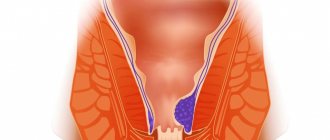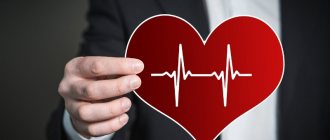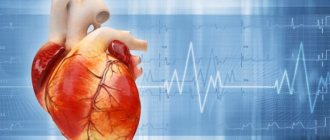Breathe slowly
How to get rid of panic attacks? Slow breathing helps to cope with a rapid heartbeat and shallow breathing, which are both symptoms of a panic attack and its provocateurs. By breathing slowly, you send a signal to your brain to calm down. This is one of the most effective physiological ways to stop a panic attack.
Focus on your breathing. Inhale for one-two-three-four, hold your breath for one second, exhale for one-two-three-four. Look at your stomach (even through clothes): how it inflates as you inhale and retracts as you exhale.
Vegetovascular dystonia: what is it and how to treat it?
“All diseases come from nerves...” Everyone knows this common phrase. Someone will agree with this, someone will laugh and say that psychiatrists would like it that way. However, it is difficult to deny that mental factors greatly influence well-being. Fatigue, pale appearance, dizziness, tinnitus - this set of symptoms is often combined with the diagnosis of “vegetative-vascular dystonia”. What kind of disease is this? How to treat it? What factors influence our well-being? Is it possible to get rid of weather sensitivity? What is the “placebo effect” and why should you not get carried away with physical procedures? You can read about this and much more in an interview with a professional in somatic medicine, Candidate of Medical Sciences, Associate Professor of the Department of Faculty Therapy No. 1 of the First Moscow State Medical University. I. M. Sechenov Anton Vladimirovich Rodionov.
— What is vegetative-vascular dystonia? Is this a disease or a syndrome?
- Neither one nor the other. Vegetative-vascular dystonia is a kind of “garbage dump”, which contains a huge number of symptoms that the doctor, as a rule, does not really want to deal with. This includes a variety of conditions, ranging from “oh, mom, boys don’t like me,” to severe mental and neurological diseases. This disease is not included in the International Classification of Diseases (ICD); it was invented by “Soviet scientists.” And it’s not bad that it’s made up, the trouble is that often behind this pseudo-diagnosis lie completely understandable, recognizable diseases that can and should be treated. Instead, patients are often offered a huge range of dubious treatment methods with unproven effectiveness.
— When did this diagnosis appear? Why, as you say, was it invented?
— This diagnosis is already 100 years old, if not more. It first appeared in American literature back in the 19th century, but only in Soviet-Russian medicine did it manage to survive until the 3rd millennium. Medicine is developing very quickly and it is quite natural that once upon a time approaches to treatment and diagnosis formulations were completely different. Today, for example, it would never occur to anyone to formulate such a diagnosis as “intestinal catarrh.” It is also time for the diagnosis of VSD to take pride of place in the textbook on the history of medicine.
- Well, then let’s talk, if not about the disease (since it doesn’t exist), then about the symptom complex. What can provoke these conditions, which are collectively referred to as VSD.
— Those patients who are diagnosed with VSD in Russia should, as a rule, be observed by psychotherapists, and sometimes by psychiatrists and neurologists. Because most often these are patients who suffer from neurotic disorders - panic attacks, fears, and so on.
— What are the reasons for the development of these disorders?
- In fact, this question comes down to what causes neuroses. On the one hand, they may be based on hereditary factors, on the other hand, they may be due to external reasons, mainly stress. But this is only one side of the issue. Quite often, under the mask of VSD, diseases are hidden, which, as I have already said, can be recognized and successfully treated. For example, it could be iron deficiency anemia. A decrease in hemoglobin leads to tachycardia, heart pain, shortness of breath and other symptoms of cardiovascular disease. Some diseases of the endocrine system, such as thyrotoxicosis, have similar manifestations. And it’s very bad when, instead of prescribing a patient to test for iron, thyroid-stimulating hormone, and so on, they begin to treat him in an unclear way.
— There are about 40 symptoms of VSD in the literature...
- I think there are many more of them. (Smiles.)
— Could you list some of them?
— It is difficult to list the symptoms of a disease that does not exist. However, this diagnosis is often given to patients with complaints of palpitations, indistinct piercing pains in the heart, fainting, general weakness, and so on.
- Be that as it may, today doctors quite often make this diagnosis to their patients.
— We have a lot of problems... Dysbacteriosis alone is worth it. Unfortunately, this is a systemic learning problem. Many doctors do not strive to constantly monitor the latest achievements of world science. As they were taught at the institute in the 60s - 80s, this is how they treat. We always tell patients with a referral diagnosis of VSD: “Find another doctor, it is useless to be treated by this specialist.” Another such moment. For some reason, we believe that a doctor must make a diagnosis.
- Is not it so?
“One of my senior colleagues once wrote the following phrase in her medical history: “He’s healthy, he doesn’t need treatment.” Few modern specialists will take it upon themselves to make such a recording. And it’s not a matter of responsibility, it’s just that there is no such habit. For example, a patient comes to an appointment with a complaint that his pulse is 95 beats per minute. And I can afford to say: “This is your version of the norm. You are healthy and there is no need to treat you.” How are these standards calculated? For example, 10 thousand clinically healthy people are taken, some indicator is measured from them (in this case, heart rate), and then 2.5% of the percentage is “bitten off” on each side. Thus, 95% of people fall into a certain range (from 60 to 85 beats/min), which is called the norm. But the remaining 2.5% on the right and left, who live with a pulse of 55 and 95 beats/min, are also healthy! And the doctor’s task is to understand this situation and draw the right conclusions. Of course, tachycardia can be a symptom of various diseases - arrhythmia, thyrotoxicosis, anemia, pulmonary failure, neurotic disorders, including depression.
— What happens in a person with a neurotic disorder?
- Let's first figure out in what case a healthy person needs to increase the pulse rate and increase blood pressure. Tachycardia normally occurs when it is necessary to respond to an external stimulus, for example, to run away from danger. In this situation, the muscles need more blood, therefore the heart must increase its heart rate. But when the danger passes, the pulse returns to normal. A patient with a neurotic disorder is outwardly calm, no one is chasing him, he does not need to catch up with anyone. But the brain gives a signal: “You are in danger, run away!”, and this whole cascade of reactions that I talked about is launched. And in this case, treating tachycardia as a symptom is at least absurd; the disease itself must be treated. And such patients should be managed not by a cardiologist or a therapist, but by a psychiatrist or psychotherapist.
— Should you also see a psychiatrist for cardioneurosis?
- Yes. In fact, this is also a neurotic disorder with certain “cardiological” manifestations. Nowadays the diagnosis is not formulated this way; this is also a “legacy” from the 50s and 60s. last century.
- Sorry, but this diagnosis is also often made in our clinics...
“First of all, this is due to the fact that in our country we do not have a properly functioning system of postgraduate education for doctors. Naturally, there are certification courses that a doctor must attend once every five years, but what he does there is his own business; no one seriously controls this process. And I don’t know a single doctor who, after five years, would not be able to confirm his certificate.
— When you talk about insufficient professional competence, then, as far as I understand, we are talking about doctors of the older generation?
“Fortunately, we see such diagnoses less and less often. And I am sure that my students will not write such a diagnosis with their own hands. And, probably, they will continue to teach someone. So I look into the future with a certain degree of optimism.
— Let's return to the VSD. What should patients do if their doctor has given this diagnosis? Who can help them?
— You cannot equate the absence of a diagnosis as such with the absence of a disease in a person. If I say that the diagnosis of VSD is fictitious and does not exist, this does not mean at all that I consider this patient to be a malingerer. First of all, it must be carefully examined. But it also happens that you just need to talk to the patient and understand that his “VSD” is the result of loneliness and some kind of complexes. And also to the question of “schools”. My teachers (they, unfortunately, have already passed away), Corresponding Member of the Russian Academy of Medical Sciences Vladimir Ivanovich Makolkin and Doctor of Medical Sciences Stanislav Alekseevich Abbakumov, dealt with patients with similar disorders, they formulated such a condition as “neurocirculatory dystonia”, in the 80s - 90s ‑e years of the last century this was the scientific topic of our department. As a result of this work, a wonderful psychosomatic center was created at the clinic, and such patients still come to us. But in the 21st century, we no longer allow ourselves to diagnose VSD; we do not treat them with adaptogens and physiotherapy, but refer them to specialized specialists, from whom they receive adequate psychotherapeutic and sometimes psychiatric help. Our clinic employs a wonderful team of psychotherapists who are well aware of the approaches to these patients.
— What are psychosomatic disorders?
— Initially, these are diseases of the central nervous system, which manifest themselves as somatic, that is, bodily complaints. Often these people go from one specialist to another for years with a variety of complaints. Very often, these symptoms disguise “somatized depression.” Every year there are more and more such patients. If the patient understands that this is depression and begins treatment for this particular disease, then he quickly gets rid of all painful sensations.
— Many people associate their poor health, in particular pressure changes, with weather disasters.
— During the day, any person’s blood pressure fluctuates between 50–60 mm Hg. Art. A healthy person may have a blood pressure of 90⁄60 mmHg during moments of rest. Art., during sports 160⁄100 mm Hg. Art., and this is normal, physiological and is not a cause for concern. Therefore, there is no need to attribute all symptoms, especially headaches, to the dynamics of blood pressure - this is a very big misconception. For healthy people, there is no lower limit of normal blood pressure, so hypotension should not be attributed to poor health.
- Okay, that's sorted out. What can you say about such a concept as meteosensitivity? Is this also from the field of psychosomatics?
— Weather sensitivity is a myth that was created mainly by the media. They don't get sick because of the weather. As one of our great teachers, the now living professor Abram Lvovich Syrkin, told us, when we were still students: “Never attribute the poor health of your patients to age and weather.” And indeed it is. I am sure that if every morning they don’t say on the radio that there is a magnetic storm today, then people will soon forget about it altogether. In general, it seems to me that hypotension and weather sensitivity are diseases of urban residents. If you get up at 4 am, light the stove, milk the cow, cook breakfast and do a bunch of other household chores, I assure you that there will be no trace left of thoughts about the weather and low pressure.
— Interesting... What other “urban diseases” are there?
— First of all, chronic stress. Residents of megacities have a very high incidence of neurotic disorders. Objectively, we are accustomed to the fact that arterial hypertension is a disease of those over 40. But today we see that at the age of 25–30 people come to us with classic hypertension. Not least of all, this is due to living under stress and other known risk factors.
— Let's return to the main topic of our conversation. How are psychosomatic disorders treated today? With medication or, for example, physiotherapy, or some unconventional methods?
— No, we do not use physical therapy. Let's start with the fact that “physical therapy” translated from English is physical therapy and rehabilitation. This is not hardware physiotherapy with devices - a magnet, laser, UHF. These methods have not been used abroad for a long time.
— And here they use it, and quite actively. And there seems to be some benefit. What is the reason for this? Maybe it’s the so-called placebo effect?
- To some extent, yes. They work with the patient, he goes for procedures, they wrap him, warm him up, do all sorts of other manipulations, that is, the process goes on...
- But if it really helps people, maybe we should leave everything as it is? Essentially, why is this worse than seeing a psychotherapist?
— The whole question is who will pay for this attraction. All these manipulations cost specific money. And this is an expensive placebo - keeping the patient in the clinic for 10 days and doing procedures that will probably make him feel better psychologically. On the other hand, for the same money you can provide the patient with high-quality treatment, which will be much more effective than using a placebo. In this case, the doctor should not follow the patient’s lead and prescribe unnecessary manipulations just because it seems to help him or he is used to such “treatment.” This is absolutely unacceptable.
The text of the original article is posted on the website med-info.ru in the “Interview with an expert” section under the heading “Anton Rodionov: “Vegetative-vascular dystonia is the history of medicine,” author Irina Tretyakova.
- about the author
- Publications
about the author
Emma Abbasova
Professional experience in the specialty of psychiatry since 2004. She worked in the treatment department of a psychiatric hospital, from 2011 to the present as the head of the psychiatric treatment department.
Publications
Emma Abbasova
- Vegetovascular dystonia: what is it and how to treat it?
10.10.2016 - How emotions cause physical illness
01.08.2016
Admit you are having a panic attack
How to understand that you are having a panic attack and get rid of it? During a panic attack, a person catastrophizes what is happening: it seems that it is a heart attack, stroke, death, madness, that you are fainting or about to vomit.
Tell yourself mentally several times: “This is not a disaster, this is a panic attack.” The intensity of your symptoms will decrease and you will begin to regain consciousness.
Beck Scale: Test for Anxiety
Diagnosis of the disease
PA is a specific mental disorder that causes difficulties in diagnosis. It is not always possible, even after an examination and conversation with a psychiatrist, to determine what caused this condition - problems with the cardiovascular system, autonomic dysfunction, mental disorder. The neurologist checks reflexes, listens to the lungs, measures blood pressure, and examines the patient's abdomen to rule out internal bleeding. It is important to establish that these are paroxysms, and not a heart rhythm disorder or a heart attack. The patient undergoes an electrocardiogram, MRI, breathing tests, and an ultrasound examination.
Train your mindfulness
Mindfulness is the ability to notice what is happening in and around you.
Panic attacks often lead to a feeling of unreality, out-of-body, detachment from one's own body and from the world. Mindfulness helps cope with a panic attack and the first signs of its approach.
How to deal with panic attacks? Focus on your body, look at it or imagine with your eyes closed: how your feet touch the floor, how your clothes touch your skin, mentally move to the tips of your fingers.
To distract yourself, you can focus your gaze on familiar objects around you - a glass with pens and pencils, a plant on the window, a pattern on the wall or on the floor, and so on.
General recommendations
Maintaining the correct daily routine is an important point in the fight against nervous tension.
You need to create your daily routine in such a way that there is enough space for both work and rest. It is also important to alternate between work and rest.
Sound and healthy sleep is something you desperately need. Moreover, it should occur precisely at night and be at least 8 hours a day.
You will have to eliminate alcohol and other stimulating drinks : coffee, strong tea. They excite the nervous system and prevent you from relaxing. Instead, drink soothing herbal infusions based on mint, lemon balm, chamomile, and linden.
Review your diet . Leave only healthy food in it. More vegetables and fruits are beneficial.
Constantly repeat to yourself that sport is your assistant in the fight against relapses of panic attacks. This is an excellent method for relieving tension and releasing negative energy. It increases the level of endorphins in the blood and reduces the amount of stress hormones. In addition, sports will allow you to abstract from your problems. Believe me, a hundred jumping ropes will bring you out of the blues and save you from gloomy thoughts.
In addition, physical exercise improves blood circulation, eliminates muscle tension, and liberates the body. It gives self-confidence, activates thinking, teaches self-control, and, of course, tightens the figure, makes it slimmer, and the image more harmonious. You will receive enormous benefits from playing sports, improve your sense of self and self-perception, and free yourself from certain complexes.
Stop the attack with medication
Drugs from the group of tranquilizers (anxiolytics or anti-anxiety drugs) help stop a panic attack if you take the pill at a time when it is still in its infancy.
Tranquilizers cannot be taken by everyone; they are sold by prescription, so they must be prescribed by a psychiatrist or psychotherapist.
Panic attacks. Why don't pills help?










